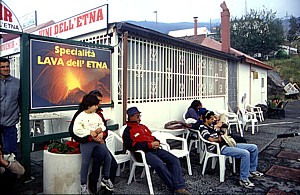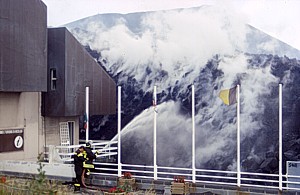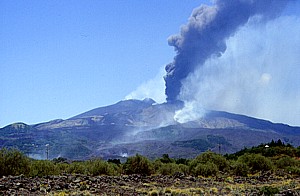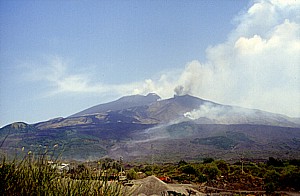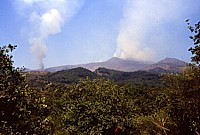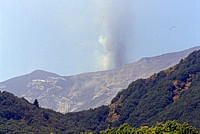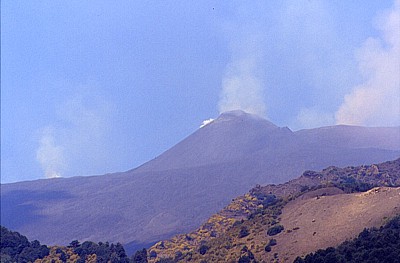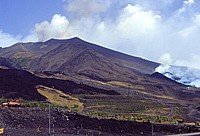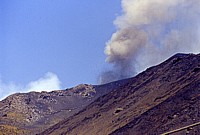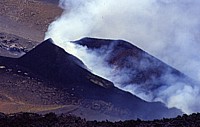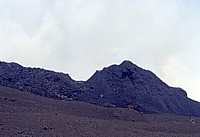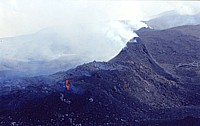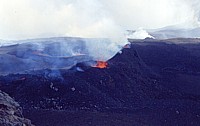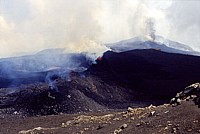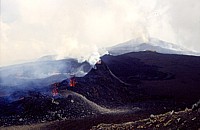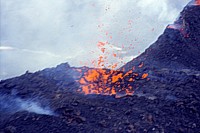| Etna
index |
||
| Geology | Geological history | Cones and craters |
| Eruptive characteristics | Eruptions before 1971 | Eruptions since 1971 |
| Etna and Man | References | Web sites |
| Weather forecasts | FAQ | Latest news |
Etna
photo gallery: 2001
Etna makes the news
![]()
On 25 July
2001, the eruption enters into its most intense and most spectacular phase,
which is to last about five days. Eruptive activity is occurring at no
less than seven different eruptive fissures, and it is gradually becoming
evident that two of them (on the southern flank at 2100 and 2570 m elevation)
belong to a different system of feeder conduits than the other fissures.
The lavas emitted from the two southernmost sites contain abundant inclusions
of sedimentary rock (entrained by the magma when it rose through the sedimentary
basement of the volcano) and, more exceptionally, a mineral named amphibole
(which contains limited amounts of H2O in its crystal structure).
Following about one week of ash-rich phreatomagmatic activity, the vents
at 2570 m elevation change their activity during the night of 24-25 July,
and instead of relatively silent ash emissions there are now magmatic
explosions, accompanied by tremendous detonations, and lava begins to
flow out, producing the most devastating flows of the entire eruption.
During the following days, a huge new cone begins to grow around the main
vent at 2570 m, and the morphology of the upper south flank of Etna changes
beyond recognition. Its lava flows burn and destroy the arrival station
of the cable car, and everything man-made around the growing cone is utterly
devastated.
During the last days of July, while the newly forming cone experiences
the climax of its activity, the highest of the eruptive fissures, on the
northeastern and southeastern sides of the Southeast Crater, cease their
activity, and it soon becomes evident that the 2001 flank eruption is
gradually losing strength. During the first week of August, more eruptive
fissures progressively shut down, until, on the late evening of 9 August,
also the vents at 2100 m elevation fall silent and the eruption is over
after 24 days.
After several days of nearly continuous encounters and interviews with journalists (mostly from Germany and the United States), which took place always in the Rifugio Sapienza area, I finally began to obtain different views of the eruption from 25 July onwards. Until then, I had seen little more than the eruptive vents at 2100 m elevation, which were those that were brought on the TV screens to millions of people all over the world. On 25 July I finally convinced a group of reporters to drive around the volcano to its eastern side, from where a different perspective could be obtained. The day after, we drove up to Piano Provenzana on the northern side of the volcano, where normal tourist business was going on (this area was not affected by the 2001 eruption but would be devastated by an eruption little more than one year later), and made a long hike to the uppermost vents of the eruption, near the Southeast Crater. Contrary to the declarations made in television by some important Italian volcanologists, the activity there is still vigorous and building up a group of peculiar hornitos, while further downslope, at 2570 m, a huge new cone begins to form around the most violently active vents of the eruption.
View
towards the Southeast Crater from east on 25 July 2001, with gas
escaping from the summit of its cone (the peculiar dark rock feature
on its eastern side is the "Levantino" vent, which had
been active for half a year before the July-August 2001 eruption,
and continued to emit lava into this eruption). A brownish plume
rises from the Bocca Nuova at right, and a small, light-colored
plume at left marks the site of the eruptive fissure at 2950 m elevation,
the first of the new eruptive fissures to open on 17 July |
Etna's
new violent baby: following the shift from phreatomagmatic to magmatic
activity at the vents at 2570 m elevation, a large cone begins to
grow around the most vigorous of these vents, seen here from about
2950 m on 26 July 2001. At that time, the cone is highly irregular,
its eastern rim being highest (about 50-60 m). The building in the
foreground is the Torre del Filosofo mountain hut, which has already
survived several assaults by lava flows from the Southeast Crater
and is going to be left unharmed also by this eruption (another
eruption, in late 2002, will bury the building under a thick pyroclastic
deposit). Behind the actively growing new cone lies the Montagnola,
a large pyroclastic cone formed during an eruption in 1763 which
was similarly explosive |
Seen
from the summit of the "Sudestino", one of the vents at
2950 m elevation produces a large magma blister that eventually
explodes. In the background the roof of the Torre del Filosofo mountain
hut can be seen before the growing cone at 2570 m elevation |
Return to the Etna photo gallery
Copyright © Boris Behncke, "Italy's Volcanoes: The Cradle of Volcanology"
Page set up on 23 November 2003; last modified on 6 December 2003

